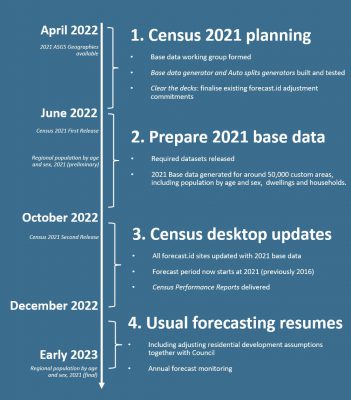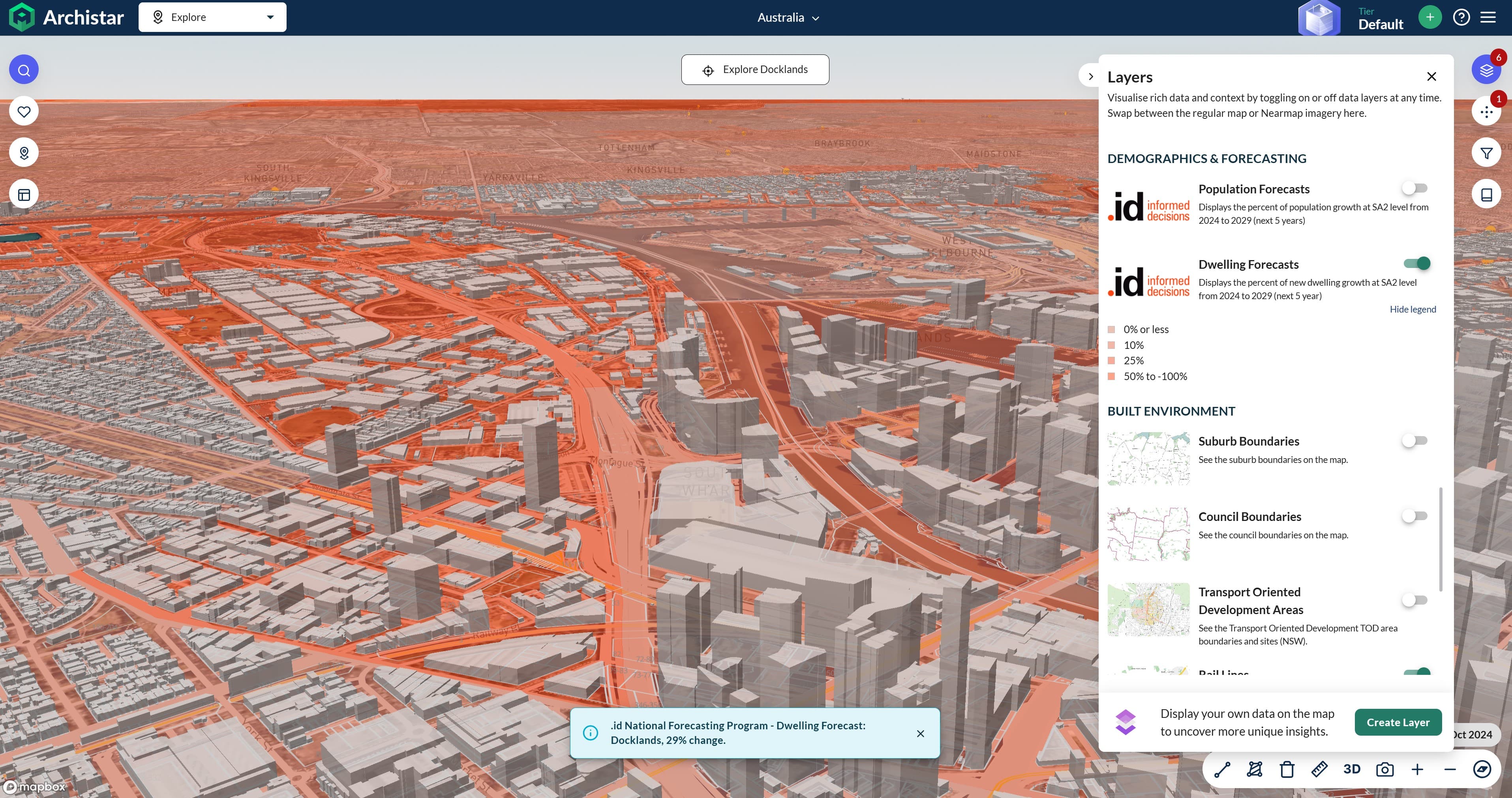With the release of 2021 Census data fast approaching, our Local Government Population Forecasting Team is preparing for the ‘most anticipated Census in a generation’.
In this blog, Andrew Rossiter shares how Census information is used in a population forecast, what topics our forecasters are keeping a close eye on, and how Australia’s largest Local Government Population Forecasting team is preparing to incorporate this valuable information in your population forecast.
The most anticipated Census of a generation?
The Census is Australia’s largest statistical collection. For over 100 years, it has provided a snapshot of Australia and insight into how our communities have changed over time.
However, never before has an Australian Census been undertaken in the middle of a demographic and economic shock as significant as the COVID-19 pandemic.
Actually, you need to go back to WW1 to find an event which has impacted population growth to anywhere near that of COVID-19. And back then, Australia had to wait more than three years after the end of the war to officially calibrate its impacts through the 1921 Census.
100 years later, the 2021 Census is arguably the most anticipated Census in a generation! And our population forecasters are looking to it to plan for the future in two main ways:
1. It gives us the opportunity to improve your forecasts, including communicating their performance, as well as a forensic examination on what we can learn about our assumptions, and
2. Allows us to recalibrate and rebase your population forecast with gold standard and up-to-date information.
How will the 2021 Census help us to improve your population forecast?
Census information is the single most important dataset used in the creation of population forecasts. Undertaken every five years, this information gives us the opportunity to assess in detail our forecast assumptions, as well as sharing the overall performance of the forecast with our local government clients.
As a benchmark, in 2016, over two-thirds of forecast.id forecasts were within 2% of the Census based Estimated Resident Population. At the time we were pleased with this result as we were grappling with a Western Australian economy that had suddenly gone from ‘boom to bust’ affecting many of our forecast outcomes in that state.
This time around, we are just as keen to assess our performance, particularly regarding our assumptions on the impacts of COVID-19.
In case you missed it, in mid 2020 we began including the impacts of COVID-19 in our population forecasting assumptions. This was informed by our Impacts of COVID-19 on population growth framework, and although well evidenced, some of these assumptions were the boldest many of our forecasters had ever made. So naturally, we are keeping a close eye on the Census results to see how well we did.
The types of Census information our population forecasters will be keeping the closest eye on include:
- Population growth. While we know overall population growth has slowed significantly, how accurate were our small area assumptions? Were CBD, inner-city and growth areas as negatively impacted as we expected? Did other regional and coastal communities experience a different trend?
- Residential development (dwelling counts). Influenced by a growing range of factors including, border closures, residential construction and supply chain disruptions/shortages on one side, and strong pent-up domestic demand and government stimulus on the other, we are keeping a close eye on how our residential development assumptions have fared.
- Migration. That simple question “Where did you live one year ago (and five years ago)” reveals an array of information about who is attracted to, and from, a particular area. We use this to describe the ‘role and function’ of a place. How accurate were our assumptions and the ABS’ Regional Internal Migration Estimates? For example, how large was the net-outflow from CBD and inner-city areas, to suburban and regional areas?
- Vacancy rates (unoccupied dwellings). We have made some bold assumptions about recent dwelling vacancy rates, by increasing rates in CBD and inner-city areas, while tightening rates in other areas including some suburban areas and much of regional Australia. The 2021 Census information will be valuable in evidencing these assumptions.
- Age structure. How much has overall aging accelerated due to less overseas migration (from younger adults) and fewer births (declining fertility in times of economic/social uncertainty coupled with less overseas migration from family forming age groups)?
- Household formation. Will we see larger household sizes in established metropolitan areas and much of regional Australia, as many young adults have delayed moving out or have moved back with their parents due to the economic shock? Will we also see a higher share of ‘couples without children’ in adult age groups, due to decisions on when to have children being delayed?
When will the new information be reflected in my forecast?
The 2021 Census provides an opportunity to rebase all our forecasts with up-to-date and reliable data, rather than numbers based on old 2016 Census information.
This is no small task, and to incorporate this information (base data) as quickly and smoothly as possible our Local Government Population Forecasting team has assembled a (multi-generational) Base data working group. We are also planning a phased approach (as shown in below).
forecast.id 2021 Census update timeline

1. 2021 Census planning (April 2022 – June 2022)
One of the first jobs for the Base data working group will be to build the systems to rapidly generate forecast base data for around 50,000 underlying geographic areas.
To do that, the group is planning to build and test two new processors capable of generating the data with far less human intervention than the 2016 Census. These processors include:
- Base data generator – designed to crunch the several datasets from the ABS into forecast base data for around 50,000 underlying geographic areas
- Auto splits generator – designed to split the underlying base data into any one of the 2,500 existing forecast.id small areas you see on our 130 plus forecast.id websites.
During this period the Forecast Team will be clearing the decks of all existing forecast commitments, in order to focus primarily on the speedy delivery of Census 2021 Desktop updates.
2. Prepare 2021 forecast base data (June 2022 to October 2022)
Now will be time to put the base data generator through its paces, with the two datasets we need to create the 2021 base data expected for release. These are:
1. 2021 Census first release (expected June 2022),and
2. Estimated Resident Population (prelim) by age group, by LGA (expected August 2022).
Together, this information will allow us to update all forecasts with 2021 actual data. This will include the number of residents by age and sex, the number dwellings and detailed household information.
By the beginning of October, we anticipate the 2021 Census base data will be prepared and ready for application to all population forecasts.
3. Census desktop updates (October 2022 to December 2022)
We will now update every Local Government Population Forecast (over 130 in Australia) with the new 2021 base data.
We anticipate the work will be conducted between October 2022 and December 2022. We will notify you well before this is commenced and after it has been completed. The adjustment will be conducted in-house, and will not require any input from council (as it is an update to demographic data only).
At this time we will also be providing councils with a 2021 Census Performance Report of how well your forecast has performed against Census information.
4. Usual forecasting resumes (early 2023)
From early 2023, we will resume our usual forecasting program, including annual forecast monitoring, as well as undertaking reviews of residential development together with the council to reflect your strategic planning policies.
Don’t currently have a population forecast, or want to stay informed?
It goes without saying that this year is going to be one of the biggest for our Local Government Population Forecasting Team as we focus primarily on Census 2021.
If you are considering getting a population forecast, you may want to consider contacting us now to secure your spot before the program ramps up later in the year. This will be the surest way you get a forecast with 2021 data as quickly as possible.
We will keep our clients informed with regular progress updates. If you would also like to keep informed with our progress throughout the year, as well as other forecast related insights, sign up to the forecast.id newsletter here.
Any other questions? Please get in contact.










